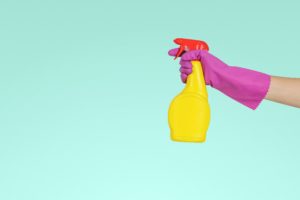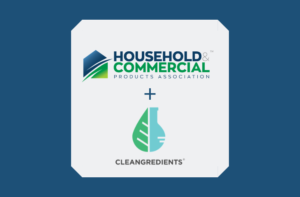Ah, spring. Time to enjoy the warm weather … and take on some of the cleaning tasks you’ve been putting off all winter. But did you know that the cleaning products you choose can affect the air quality inside your home?
Americans, on average, spend approximately 90 percent of their time indoors, where the concentration of pollutants is often several times higher than outdoor concentrations. This can be a particular concern for vulnerable populations, such as the very young, the elderly, or people with existing health conditions, who are both more vulnerable to the effects of pollution and may spend even more time indoors.
Indoor air pollution can come from a wide range of sources, including volatile organic compounds (VOCs) in the products you use, as well as off-gassing from building materials (like pressed wood products that can emit formaldehyde), combustion of wood or fossil fuels in fireplaces or appliances, intrusion of radon or VOCs from subsurface contamination into the building, and even mold. The problem can be exacerbated by modern building techniques, which seal the building from air leaks to promote energy efficiency, but can reduce indoor air quality if there isn’t appropriate ventilation.
Short-term and long-term health effects associated with poor indoor air quality depend on the specific contaminants present. For example, VOCs can contribute to asthma; eye, nose, and throat irritation; headaches, loss of coordination, and nausea; damage to the liver, kidneys, and central nervous system; and even cancer. Indoor air quality can also affect your cognitive function and ability to concentrate, so maintaining high indoor air quality is critical for schools and workplaces as well as homes.
So, what can you do to improve the air quality in your home? One of the easiest steps you can take is to choose safer formulated products, such as cleaning products, thereby reducing sources of indoor air contaminants. Since many conventional cleaning products are high in VOCs and other potential air contaminants, it is important to choose safer low-VOC products to use in your home. Even cleaners made from natural materials can contribute to indoor air quality problems. For example, cleaning products that contain terpenes (e.g., pine or citrus oils) can react with ozone (either from outdoor pollution entering the building or from ozone generators sold as air cleaners) in the air within your home to produce formaldehyde, fine particulate matter, and other pollutants.

When shopping for household cleaners, look for products with the EPA Safer Choice label. These products are required to have lower levels of VOCs to reduce impacts on indoor air quality, plus all ingredients have been screened by EPA and are safer for your family’s health and the environment. The Safer Choice program follows the VOC standards for consumer products established by the California Air Resources Board (CARB) and the Ozone Transport Commission. These agencies set VOC content limits for personal care products, cleaning products, adhesives, aerosol paints, and more based on the type of product.
Other steps you can take to improve indoor air quality include using paints and other household chemicals with low VOC content, avoiding dry cleaners that use hazardous solvents such as perchloroethylene, and avoiding new building materials such as particle board, plywood, and medium-density fiberboard (often used in subflooring, cabinets, or furniture). If you must use these materials in your home, ensure that adequate ventilation is present. In addition, some studies suggest that houseplants can improve indoor air quality; however, their effectiveness in real-world situations is uncertain.
Indoor air quality is a serious concern. One of the simplest things you can do to improve indoor air quality is to choose safer products that are lower in VOCs – so when you do your spring cleaning this year, look for the Safer Choice logo and enjoy the fresh air indoors and out!












